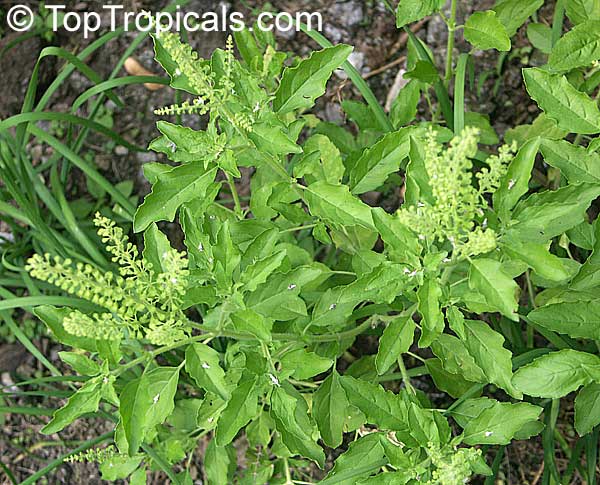Ocimum tenuiflorum (Holy basil)
Top Tropicals Plant Encyclopedia
Botanical names: Ocimum tenuiflorum, Ocimum sanctum
Common names: Holy basil, Thai Basil, Holy Basil, Tulsi Plant
Family: Lamiaceae
Origin: India







Ocimum tenuiflorum, commonly known as Holy Basil, is an aromatic and fragrant herb native to India. Growing in USDA Zone 9-11, it is an ethnomedical plant, most well known for its use in religious and spiritual ceremonies in India, and its use as a traditional spice and herb.
This plant is a perennial, low growing, and makes for a great groundcover, reaching only 2ft in height. It can also be grown in small pots and does well in colder regions, although it prefers a hot and dry climate. Holy Basil can be grown in full sun or partial shade, but prefers the former. As with any plant, regular waterings are necessary to keep soil moist.
The aromatic leaves of Ocimum tenuiflorum are dark green and oval, with small flowers that range in color from white to pink. This Holy basil cultivar is characterized by an intensive sweet-camphoraceous fragrance, making it both an ornamental and medicinal plant. It can be pruned to keep it looking neat, or simply enjoyed in its natural state, with its delicate perfume.
Grown in gardens, Holy basil plants can reach heights of 2-5ft, and produce small flowers throughout the year. The plants are easy to care for; it does not require intensive pruning or maintenance, and occasional feedings with a general fertilizer should provide it with the nutrients it needs. Protect it from cold and frost in winter to ensure it continues to thrive.
In India, Ocimum tenuiflorum is held in high esteem, used not just as an herb, but also in religious and spiritual ceremonies. It is sacred to Vishnu, and often symbolizes his wife Lakshmi, or the wives of his various avatars.
All in all, Ocimum tenuiflorum is a great plant to add to any garden, providing a beautiful, fragrant addition to outdoor spaces. Its aromatic qualities, as a medicinal and spiritual herb, make it an ideal choice for both ornamental and ethnomedical use.
